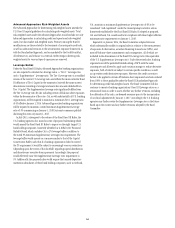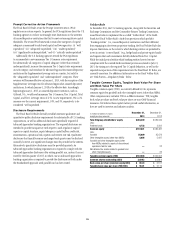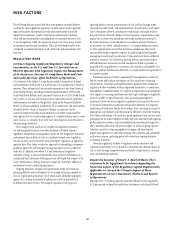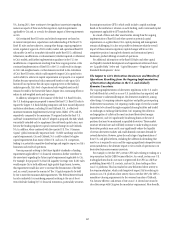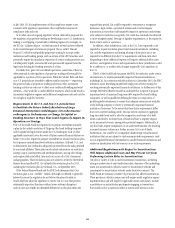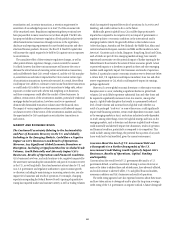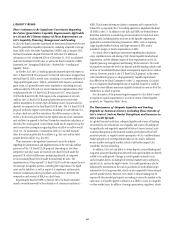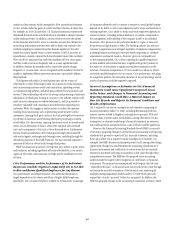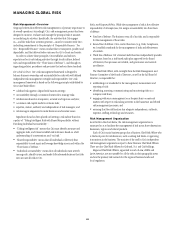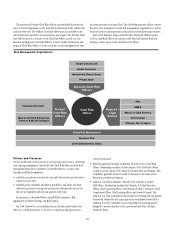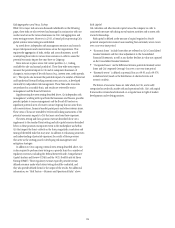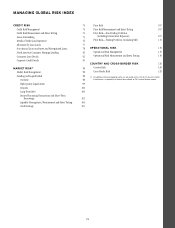Citibank 2013 Annual Report Download - page 81
Download and view the complete annual report
Please find page 81 of the 2013 Citibank annual report below. You can navigate through the pages in the report by either clicking on the pages listed below, or by using the keyword search tool below to find specific information within the annual report.63
and financial institutions with which Citi interacts may exercise the right to
require additional collateral based on these market perceptions or market
conditions, which could further impair Citi’s access to and cost of funding.
As a holding company, Citi relies on dividends, distributions and other
payments from its subsidiaries to fund dividends as well as to satisfy its debt
and other obligations. Several of Citi’s subsidiaries are subject to capital
adequacy or other regulatory or contractual restrictions on their ability to
provide such payments. Limitations on the payments that Citi receives from
its subsidiaries could also impact its liquidity.
The Credit Rating Agencies Continuously Review the
Ratings of Citi and Certain of Its Subsidiaries, and
Reductions in Citi’s or Its More Significant Subsidiaries’
Credit Ratings Could Have a Negative Impact on Citi’s
Funding and Liquidity Due to Reduced Funding Capacity
and Increased Funding Costs, Including Derivatives
Triggers That Could Require Cash Obligations or
Collateral Requirements.
The credit rating agencies, such as Fitch, Moody’s and S&P, continuously
evaluate Citi and certain of its subsidiaries, and their ratings of Citi’s and
its more significant subsidiaries’ long-term/senior debt and short-term/
commercial paper, as applicable, are based on a number of factors, including
standalone financial strength, as well as factors not entirely within the
control of Citi and its subsidiaries, such as the agencies’ proprietary rating
agency methodologies and assumptions, the rating agencies’ “government
support uplift” assumptions, and conditions affecting the financial services
industry and markets generally.
Citi and its subsidiaries may not be able to maintain their current
respective ratings. A ratings downgrade by Fitch, Moody’s or S&P could
negatively impact Citi’s ability to access the capital markets and other sources
of funds as well as the costs of those funds, and its ability to maintain certain
deposits. A ratings downgrade could also have a negative impact on Citi’s
funding and liquidity due to reduced funding capacity, including derivative
triggers, which could take the form of cash obligations and collateral
requirements. In addition, a ratings downgrade could also have a negative
impact on other funding sources, such as secured financing and other
margined transactions for which there are no explicit triggers, as well as on
contractual provisions which contain minimum ratings thresholds in order
for Citi to hold third-party funds.
Moreover, credit ratings downgrades can have impacts which may
not be currently known to Citi or which are not possible to quantify. For
example, some entities may have ratings limitations as to their permissible
counterparties, of which Citi may or may not be aware. In addition, certain
of Citi’s corporate customers and trading counterparties, among other clients,
could re-evaluate their business relationships with Citi and limit the trading
of certain contracts or market instruments with Citi in response to ratings
downgrades. Changes in customer and counterparty behavior could impact
not only Citi’s funding and liquidity but also the results of operations of
certain Citi businesses. For additional information on the potential impact of
a reduction in Citi’s or Citibank, N.A.’s credit ratings, see “Managing Global
Risk—Market Risk—Funding and Liquidity—Credit Ratings” below.
LEGAL RISKS
Citi Is Subject to Extensive Legal and Regulatory
Proceedings, Investigations, and Inquiries That Could
Result in Substantial Losses. These Matters Are Often
Highly Complex and Slow to Develop, and Results Are
Difficult to Predict or Estimate.
At any given time, Citi is defending a significant number of legal and
regulatory proceedings and is subject to numerous governmental and
regulatory examinations, investigations and other inquiries. These
proceedings, examinations, investigations and inquiries could result,
individually or collectively, in substantial losses.
In the wake of the financial crisis of 2007-2009, the frequency with
which such proceedings, investigations and inquiries are initiated, and
the severity of the remedies sought (and in some cases obtained), have
increased substantially, and the global judicial, regulatory and political
environment has generally become more hostile to large financial
institutions such as Citi. Many of the proceedings, investigations and
inquiries involving Citi relating to events before or during the financial
crisis have not yet been resolved, and additional proceedings, investigations
and inquiries relating to such events may still be commenced. In addition,
heightened expectations of the financial services industry by regulators
and other enforcement authorities have led to renewed scrutiny of long-
standing industry practices, and this heightened scrutiny could lead to
more regulatory or other enforcement proceedings. The complexity of
the federal and state regulatory and enforcement regimes in the U.S.,
coupled with the global scope of Citi’s operations and the increasing
aggressiveness of the regulatory environment worldwide, also means that a
single event may give rise to a large number of overlapping investigations
and regulatory proceedings, either by multiple federal and state agencies
in the U.S. or by multiple regulators and other governmental entities in
different jurisdictions.
For example, Citi is currently subject to extensive legal and regulatory
inquiries, actions and investigations relating to its historical mortgage-
related activities, including claims regarding the accuracy of offering
documents for residential mortgage-backed securities and alleged breaches
of representation and warranties relating to the sale of mortgage loans or the
placement of mortgage loans into securitization trusts. Citi is also subject to
extensive legal and regulatory inquiries, actions and investigations relating
to, among other things, Citi’s contribution to, or trading in products linked
to, rates or benchmarks. These rates and benchmarks may relate to interest
rates (such as the London Inter-Bank Offered Rate (LIBOR) or ISDAFIX),
foreign exchange rates (such as the WM/Reuters fix), or other prices. Like
other banks with operations in the U.S., Citi is also subject to continuing



